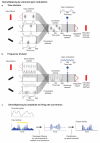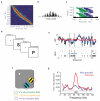Oscillatory multiplexing of population codes for selective communication in the mammalian brain
- PMID: 24434912
- PMCID: PMC4724886
- DOI: 10.1038/nrn3668
Oscillatory multiplexing of population codes for selective communication in the mammalian brain
Abstract
Mammalian brains exhibit population oscillations, the structures of which vary in time and space according to behavioural state. A proposed function of these oscillations is to control the flow of signals among anatomically connected networks. However, the nature of neural coding that may support selective communication that depends on oscillations has received relatively little attention. Here, we consider the role of multiplexing, whereby multiple information streams share a common neural substrate. We suggest that multiplexing implemented through periodic modulation of firing-rate population codes enables flexible reconfiguration of effective connectivity among brain areas.
Figures




References
Publication types
MeSH terms
Grants and funding
LinkOut - more resources
Full Text Sources
Other Literature Sources

